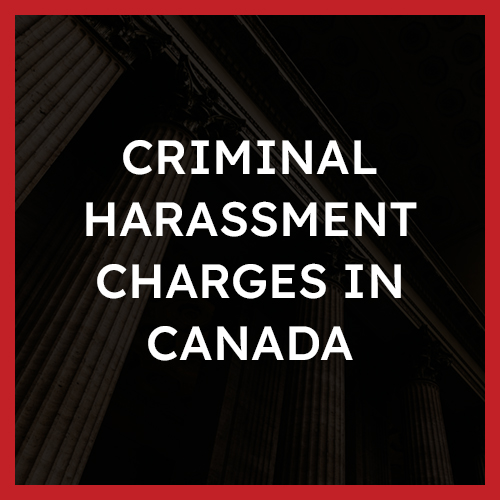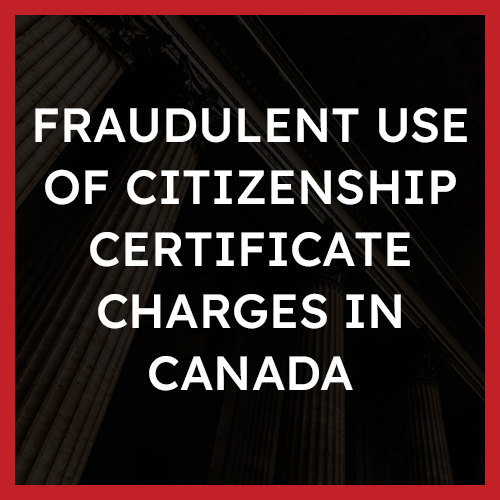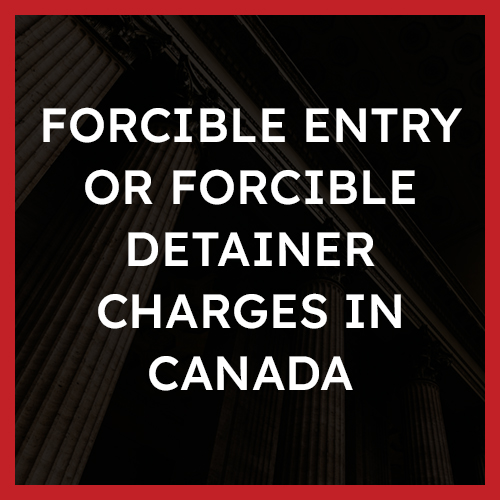Criminal Harassment (s. 264) Charges in Canada: Offences, Defences, Punishments
What is Criminal Harassment?
 Criminal harassment is covered under s. 264 of the Criminal Code.
Criminal harassment is covered under s. 264 of the Criminal Code.
Criminal harassment is more commonly referred to as stalking, but the offence can include a wide range of acts. However, the acts typically follow repeated, but unwanted attempts to communicate with the complainant.
Criminal harassment is a hybrid offence, where depending on the circumstances of your case, the Crown can elect to proceed either summarily or by indictment.
Examples
Some common examples of criminal harassment may include the following:
- Persistently sending the complainant unsolicited messages, phone calls live chats, or emails;
- Repeatedly following the complainant;
- Repeatedly watching the complainant;
- Sending the complainant unwanted gifts;
- Engaging in threatening conduct directed at the complainant or any member of their family;
- Leaving threatening voicemails; and
- Showing up uninvited to the complainant’s work or home
Defences
A strong defence to a criminal harassment charge will depend on the circumstances of your case.
However, some common defences to a criminal harassment charge include:
- Showcasing that the alleged behaviour was conducted with lawful authority;
- That the complainant did not have reasonable fear;
- There was a lack of intent;
- Mistaken identity;
- Factual innocence; and
- Any applicable Charter
Punishment
The Crown’s choice to proceed either by indictment or summarily will impact the severity of the punishment.
Criminal harassment charges do not carry with them any mandatory minimum penalties; however, the Criminal Code does list the maximum punishments as follows:
- Indictment: Up to 10 years imprisonment,
- Summary: Up to 2 years less a day imprisonment and a $5,000 fine.
Criminal Harassment Laws in Canada Infographic
Overview of the Offence
According to s.264 of the Criminal Code:
No person shall, without lawful authority and knowing that another person is harassed or recklessly as to whether the other person is harassed, engage in conduct referred to in subsection (2) [criminal harassment – prohibited conduct] that causes that other person reasonably, in all the circumstances, to fear for their safety or the safety of anyone known to them.
Under s.264(2) of the Criminal Code prohibited conduct, for the purposes of s.264 of the Criminal Code, consists of:
(a) repeatedly following from place to place the other person or anyone known to them;
(b) repeatedly communicating with, either directly or indirectly, the other person or anyone known to them;
(c) besetting or watching the dwelling-house, or place where the other person, or anyone known to them, resides, works, carries on business or happens to be; or
(d) engaging in threatening conduct directed at the other person or any member of their family.
In order for the Crown to secure a conviction for criminal harassment, the actus reus and the mens rea of criminal harassment must be proven beyond a reasonable doubt.
The case of R v Kosika, 1999 CanLII 3775 (ON CA) indicated that the Crown must prove, beyond a reasonable doubt, that:
- the accused was engaged in the conduct set out in s264(2)(a), (b), (c), or (d) of the Criminal Code;
- the complainant was harassed;
- the accused who engaged in such conduct knew that the complainant was harassed or was reckless or wilfully blind as to whether the complainant was harassed;
- the conduct caused the complainant to fear for their safety or the safety of anyone known to them; and
- the complainant’s fear was, in all the circumstances reasonable.
The Guilt Act (Actus reus)
The actus reus for criminal harassment is established by proof, beyond a reasonable doubt, of the following:
- harassment of the complainant;
- the complainant held a fear of safety;
- the fear of safety held by the complainant was reasonable; and
- that the harassment occurred through one or more of the courses of conduct set out in s.264(2) of the Criminal Code.
The case of R v Kosikar,1999 CanLII 3755 (ON CA) provided guidance as to what the Crown must prove to in order to secure a conviction for criminal harassment. The Crown must be able to demonstrate that the conduct of the accused “tormented, troubled, worried, continually or chronically, plagued, bedevilled and badgered” the victim (at para. 25). This means that harassment is more than the complaint merely feeling “vexed, disquieted or annoyed” (at para. 25).
The Crown must also prove that there was a fear of safety that the victim held. Fear of safety does not only include a fear of physical harm, rather, it also includes psychological and emotional security. However, a fear for one’s financial well-being is not enough to satisfy this requirement of the actus reus.
Not only must it be proven by the Crown that the complainant held a fear of safety, but it must be determined that this fear was a reasonable fear, which is determined on an objective standard. This means the Court must look at the totality of the circumstances and determine whether a reasonable person, in the place of the complainant, would hold this fear. The judge will also take into consideration the complainant’s gender, and the history and circumstances surrounding the prior relationship between the accused and the complainant when determining whether the fear was reasonable.
For the purposes of criminal harassment under s.264(2)(b) of the Criminal Code, the Court in R v Ohenhen, 2005 CanLII 34564 (ON CA) clarified what “repeatedly communicating” with the victim means. The Ontario Court of Appeal indicated that two communications may be sufficient to constitute “repeatedly” communicating with the victim. Determining whether there is repeated communication is a question of fact which is approached contextually. The Courts will take into consideration the conduct of the accused against the background of the relationship and/or any history between the complainant and the accused to make a determination as to whether there has been repeated communication. However, it is important to note that in some circumstances, a conviction for criminal harassment can be secured on the basis of one incident.
Under s.264(2)(c) of the Criminal Code, “besetting” has been defined, in the case of R v Eltom, 2010 ONSC 4001 (CanLII) as an active act that involves “ a physical element of approaching and, with respect to another person, importuning or seeking to argue with that person” (at para. 13). Whereas, “watching” is a passive act in which you are continuously observing the victim for a purpose.
To determine whether conduct is threatening, under s.264(2)(d) of the Criminal Code, the conduct must be assessed objectively and from the perspective of the complainant. This means that the conduct needs to be looked at alongside the circumstances in which it took place and the effect that the conduct had on the victim. It is also important to note that threatening conduct does not necessarily need to contain any threats or violent behaviour, rather, threatening conduct can be satisfied in situations where there are no words spoken at all. Threatening conduct, as defined in R v Burns, 2008 ONCA 6 (CanLII), is a “tool of intimidation which is designed to instill a sense of fear in the recipient” (at para. 2).
The Guilty Mind (Mens Rea)
The mens rea of harassment includes proving, beyond a reasonable doubt, that:
- the accused intentionally caused the conduct that violates s.264(2) of the Criminal Code;
- that the accused knew or was reckless with respect to the fact that he had no lawful authority for engaging in that conduct ; and
- that he knew that his conduct was harassing or he was reckless with respect to harassment.
Additionally, in R v Sansregret, [1985] CanLII 79 (SCC), it has been indicated that wilful blindness or recklessness will also satisfy the mens rea requirement for the offence of harassment. It is important to note that the mens rea of the offence for criminal harassment does not require that the accused could foresee that their prohibited conduct will cause the complainant to be fearful. Rather, it is sufficient that the accused knew that the complainant would be harassed by his or her conduct, or was reckless or wilfully blind in that regard,
Criminal Harassment Defences
How to Beat a Criminal Harassment Charge
The availability and strength of any defence depends entirely on the specific facts of your case. However, the following are some common defences that may be used when fighting a criminal harassment charge:
Factual innocence
A strong defence to a criminal harassment charge is to maintain that you are factually innocent. If you are able to show that the facts and the evidence do not support you being present at the time of the offence, harassing the person, or other basic elements of the offence are not met, then the Crown will not be able to secure a conviction for criminal harassment.
The alleged behaviour was conducted with lawful authority
A common defence to an allegation of criminal harassment is that the alleged behaviour was conducted with lawful authority. For example, lawful behaviour could include a debt collector calling someone incessantly to obtain funds or repeated attempts to contact someone to serve court documents. In these examples, there is lawful authority for repeated contact and would not amount to “harassing” someone for the purposes of a criminal harassment conviction.
The complainant did not have reasonable fear
In order for the Crown to secure a conviction of criminal harassment, it must be proven that your alleged conduct caused the complainant to have reasonable fear. As such, another defence to a criminal harassment charge is to demonstrate to the judge that the alleged conduct did not cause the complainant to reasonably have fear. If you are successful in doing so, the Crown will not be able to prove the actus reus for criminal harassment, beyond a reasonable doubt, and you cannot be convicted of criminal harassment.
Lack of intent
The Crown has to prove both the actus reus and the mens rea, beyond a reasonable doubt in order to convict you of criminal harassment. As such, a defence to a criminal harassment charge would be to argue that not possess the requite intent required to be guilty of this offence. If you lacked the intent, then the mens rea element of criminal harassment is not proven beyond a reasonable doubt and you cannot be convicted for the offence. However, it is important to note that to successfully raise this defence you will also have to show that you were not reckless or wilfully blind as to whether your behaviour would make the complainant feel harassed.
Identity
Depending on the circumstances of your case, a possible defence to a criminal harassment charge may be to raise an identity defence. For example, you may have been incorrectly identified as the perpetrator if, for example, the conduct in question was captured on a poor-quality video. In this case, for this defence to be raised successfully, you will have to prove that you were not present at the time of the offence. This can be done by corroborating evidence, such as an alibi, to remove you from the time of the offence.
Any applicable Charter defences
The Charter sets out your rights and freedoms before and after your arrest. If the police fail to abide by these rights, either deliberately or inadvertently, it could aid in your defence. If any of your Charter rights have been violated before or after your arrest, you may be able to have some or all of the evidence that the Crown is relying on to secure a conviction excluded under s.24(2) of the Charter.
Criminal Harassment Punishment
The sentence that you may receive for a conviction for criminal harassment will depend heavily on the circumstances of your case and whether the Crown elects to proceed summarily or by indictment.
Criminal Harassment- Summary Offence
If the Crown elects to proceed summarily and you are convicted of criminal harassment, then the maximum sentence that you may receive is two years less a day in jail and/or a $5,000.00 fine.
You also have available to you the option for a discharge, suspended sentence, fine alone, fine and probation, prison and probation, prison and fine, intermittent sentence, fine probation, intermittent sentence, and a conditional sentence.
Criminal Harassment- Indictable Offence
If the Crown elects to proceed by indictment and you are convicted of criminal harassment, then the maximum sentence that you may receive is 10 years in jail.
Other than a jail sentence, you will also have available to you a discharge, suspended sentence, fine alone, fine and probation, prison and probation, prison and fine, intermittent sentence, and fine, probation and intermittent sentence. Note that you do not have available to you a conditional sentence.
Frequently Asked Questions
What is an example of criminal harassment?
Many activities can constitute criminal harassment. However, generally, criminal harassment charges arise when the complainant feels either threatened or intimidated by the accused’s conduct. An example of criminal harassment is calling someone over and over again and leaving voicemails or hanging up when they pick up the phone.
Can you go to jail for criminal harassment in Canada?
Yes, you can go to jail for criminal harassment, even if it is your first offence. Even for a less serious criminal charge, where the Crown is proceeding summarily, you may face a jail sentence of up to two years if convicted of criminal harassment.
Is criminal harassment a serious offence in Canada?
Criminal harassment is a serious offence in Canada and the Crown can proceed by indictment. Oftentimes, a conviction of criminal harassment will be punishable with jail time. In addition to any jail time, you may also face serious negative consequences such as trouble securing employment and hindering your ability to obtain immigration or travel. Additionally, in the domestic context, criminal harassment is considered particularly heinous. This is because harassment in the domestic context is usually not an isolated event in the victim’s life.
Published Decisions
R v Mckinley, 2022 ONCJ 323
The accused, after ending a brief intimate relationship with the complainant, was unable to let go of the fleeting romance that transpired between the two. The accused sent the complainant thousands of electronic communications and called the complainant incessantly. The accused was convicted of criminal harassment.
You can read the full decision here.
R v Wowk, 2019 ABQB 959
The accused and the complainant became acquainted in a fitness class they both took together and developed a friendship. The accused started calling the complainant and his spouse from unpublished numbers showing as “No Caller ID” and would leave offensive, vulgar comments, accusing the complaint of being unfaithful in his marriage and telling the spouse to divorce him. The accused was sentenced to 12 months in jail.
You can read the full decision here.
R v Plourde, 2019 ABPC 227
The complainant in this case felt like she was harassed by her husband’s killer. The accused would drive by the complainant’s house looking directly at her, walk by her house, draw fish on her driveway and on one occasion stated that he didn’t kill her husband. The Court did not find the accused guilty of criminal harassment.
You can read the full decision here.
About The Author
Ask A Question
We endeavor to respond to questions within 24 hours. If your matter is urgent, please call our office or submit a request for a free consultation.








